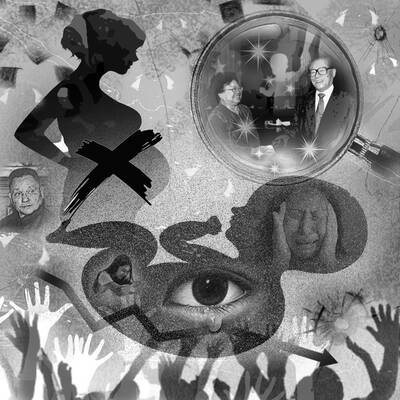Taiwan is confronting escalating threats from its behemoth neighbor. Last month, the Chinese People’s Liberation Army conducted live-fire drills in the East China Sea, practicing blockades and precision strikes on simulated targets, while its escalating cyberattacks targeting government, financial and telecommunication systems threaten to disrupt Taiwan’s digital infrastructure.
The mounting geopolitical pressure underscores Taiwan’s need to strengthen its defense capabilities to deter possible aggression and improve civilian preparedness. The consequences of inadequate preparation have been made all too clear by the tragic situation in Ukraine. Taiwan can build on its successful COVID-19 response, marked by effective planning and execution, to enhance its civilian resilience.
President William Lai (賴清德) has prioritized national preparedness by setting up the Whole-of-Society Defense Resilience Committee. In December last year, the Presidential Office held its first tabletop exercise, simulating Chinese escalation to improve government coordination and civil society response.
The first city-wide field exercise was held in Tainan on March 27. Lai observed the event, coordinating central and local government agencies, including a medical command center and trauma treatment areas.
Kaohsiung Mayor Chen Chi-mai (陳其邁) is developing a smart city model to maintain city-wide stability. In Taipei, Mayor Chiang Wan-an (蔣萬安) has advanced disaster response drills to prepare residents for evacuations. Taichung Mayor Lu Shiow-yen (盧秀燕) employs technology to bolster energy and cybersecurity. Such civilian preparedness work is expanding to enhance cities’ resilience capacity.
Structured simulations with military planners are also needed to test civilian preparedness. Tabletop exercises promote collaborative problem-solving.
Unlike typical defense studies, work under way at Stanford University’s Department of Health Policy, in partnership with the Hoover Institution and the RAND Corp, focuses on civilian well-being, especially children and women, modeling health system capacity, supply chain reliability, and community stability for naval blockades, among other conflict scenarios.
Different types of naval blockades require different stockpiles of food, water, medical and energy supplies. A direct military invasion would require evacuation facilities, civilian force utilization, trauma treatment centers and temporary housing.
Translating simulations and modeling to civilian response needs builds awareness and confidence, facilitates civilian training and provide insights to civilian leaders in planning, including protecting and acquiring critical infrastructure and supplies.
Awareness is the first step. Taiwan’s collective preparedness efforts would signal a broader lesson for democracies facing aggression. Unclassified war games from US think tanks and other groups highlight the severe costs of a Chinese invasion — casualties, economic disruption and global trade impacts — but indicate that Taiwan could endure.
Taiwan’s plan to withstand mounting geopolitical escalation could provide practical lessons for countries such as the Philippines, which faces Chinese aggression in the South China Sea. By leveraging its proven COVID-19 response, Taiwan can continue to lead in disaster preparedness and resilience to protect its citizens against Chinese coercion.
Ruth M. Gibson is a postdoctoral fellow in Stanford University’s Department of Health Policy. Kharis Templeman is director of the Hoover Institution Project on Taiwan in the Indo-Pacific Region. Jason Wang is director of the Center for Policy, Outcomes and Prevention at Stanford University.
We are used to hearing that whenever something happens, it means Taiwan is about to fall to China. Chinese President Xi Jinping (習近平) cannot change the color of his socks without China experts claiming it means an invasion is imminent. So, it is no surprise that what happened in Venezuela over the weekend triggered the knee-jerk reaction of saying that Taiwan is next. That is not an opinion on whether US President Donald Trump was right to remove Venezuelan President Nicolas Maduro the way he did or if it is good for Venezuela and the world. There are other, more qualified
The immediate response in Taiwan to the extraction of Venezuelan President Nicolas Maduro by the US over the weekend was to say that it was an example of violence by a major power against a smaller nation and that, as such, it gave Chinese President Xi Jinping (習近平) carte blanche to invade Taiwan. That assessment is vastly oversimplistic and, on more sober reflection, likely incorrect. Generally speaking, there are three basic interpretations from commentators in Taiwan. The first is that the US is no longer interested in what is happening beyond its own backyard, and no longer preoccupied with regions in other

Jan. 1 marks a decade since China repealed its one-child policy. Just 10 days before, Peng Peiyun (彭珮雲), who long oversaw the often-brutal enforcement of China’s family-planning rules, died at the age of 96, having never been held accountable for her actions. Obituaries praised Peng for being “reform-minded,” even though, in practice, she only perpetuated an utterly inhumane policy, whose consequences have barely begun to materialize. It was Vice Premier Chen Muhua (陳慕華) who first proposed the one-child policy in 1979, with the endorsement of China’s then-top leaders, Chen Yun (陳雲) and Deng Xiaoping (鄧小平), as a means of avoiding the
As technological change sweeps across the world, the focus of education has undergone an inevitable shift toward artificial intelligence (AI) and digital learning. However, the HundrED Global Collection 2026 report has a message that Taiwanese society and education policymakers would do well to reflect on. In the age of AI, the scarcest resource in education is not advanced computing power, but people; and the most urgent global educational crisis is not technological backwardness, but teacher well-being and retention. Covering 52 countries, the report from HundrED, a Finnish nonprofit that reviews and compiles innovative solutions in education from around the world, highlights a